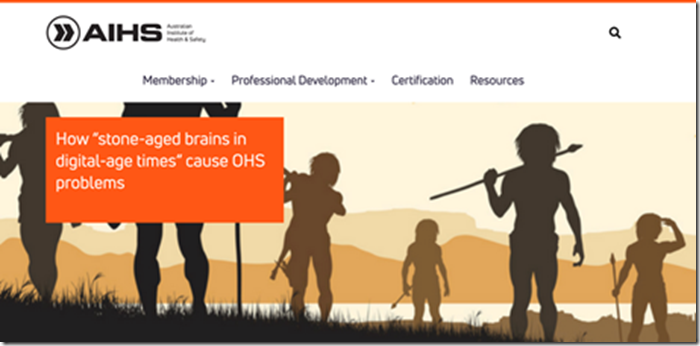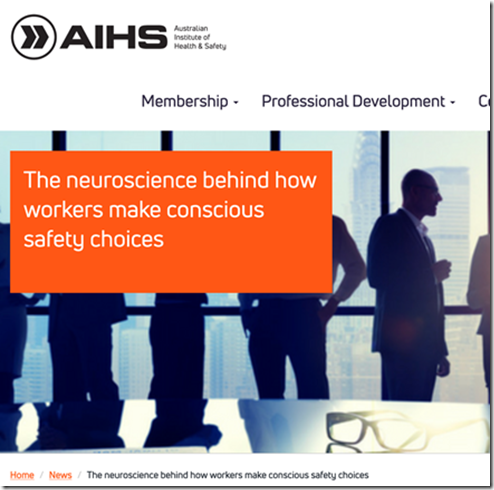I’ve noticed recently a few books released on ‘head and heart leadership’ and similar titles. Using metaphor to privilege one part of the body over another is nonsense.
If you want to ensure leadership for the whole person, then one must have an ethic and linguistics of personhood that understands embodied personhood. Drawing attention to the brain and heart misunderstands the whole person and places such understanding in a binary framework.
There is no head and heart leadership only embodied leadership, this is the pathway to envisioning the whole person.
This is the foundation for all safety in Psychosocial and Mental Health.
BoK codes, books, standards, Act and Regulation, OHS Curriculum have no foundation to tackle Psychological Safety. Indeed, the worldviews embedded (and hidden) in these documents ensures that the leadership associated is: binary, individualistic and mechanistic.
All bring and living is interaffected, intercorporeal and holistic (https://www.academia.edu/30974462/Intercorporeality_and_Interaffectivity ).
Unfortunately, the dominant methodologies of Safety fixated in behaviourism and engineering are no foundation for embodied knowing, cultural knowing and lived being. If one wants to Humanise Leadership in Risk (https://www.humandymensions.com/product/humanising-leadership-in-risk-shifting-focus-from-objects-to-persons/) and shift focus from objects to persons, then then the traditional safety worldview won’t help.
Humans are not a body directed by a head-as-computer. There is simply no evidence to support such an assertion. You can’t reprogram a brain to get a different outcome.
This kind of nonsense ‘goop’ promoted by the AIHS (See Figure 1 Stone Aged Brains) is typical of poor research and silence in safety on an ethic of personhood.
Figure 1. Stone Aged Brains
Indeed, most places in safety one reads about neuroscience is simply code for behaviourism (Figure 2. Behaviourism as Neuroscience). I discussed this here: https://safetyrisk.net/the-myth-of-neuroscience-safety/; https://safetyrisk.net/safety-and-non-neuroscience/; https://safetyrisk.net/behaviourist-neuroscience-as-safety/; https://safetyrisk.net/turning-neuroscience-into-behaviourism/). Most of the stuff presented as the neuroscience of safety is presented by engineers. Just look at the reading list at the end of this blog and see if any such research is a part of any of this branding.
This is one thing safety is good at, branding something by what it isn’t. Such is the nature of safety code (https://safetyrisk.net/deciphering-safety-code/). Just because something is branded as ‘different’ doesn’t make it so. Just because something is branded as ‘neuroscience’ doesn’t make it so.
Figure 2. Behaviourism as Neuroscience
Just look at some of these examples of Safety using the brand neuroscience pushing traditional safety agenda:
· https://myosh.com/blog/2020/06/10/the-neuroscience-of-getting-people-to-speak-up-for-safety/
· https://www.safetydimensions.com.au/whats-the-neuroscience-behind-safe-behaviour/
· https://www.tmsconsulting.com.au/blog/safety-performance-with-the-brain-in-mind/
· https://www.ohscanada.com/opinions/the-neuroscience-of-safety-leadership/
· https://www.ishn.com/articles/113376-brain-centered-safety-a-hot-topic-at-assp-safety-2022
· https://www.stratleader.net/neurosafety
· https://sentis.com.au/resources/safety-and-the-brain
· https://www.habitsafe.com.au/based-on-brain-science
All of this ‘goop’ is presented on the back of a binary worldview, poor research, behaviourist assumptions and the search for a simplistic easy fix.
Much of this is premised on the idea of the brain-as computer and heart as the metaphorical source of emotions. Most of this stuff is presented by behaviourists and engineers. It’s simplistic nonsense and it doesn’t work.
None of this is about neuroscience or leadership.
None of these auger well for an holistic understanding of persons, leadership in risk or a holistic approach to Psychosocial Safety.
Here’s one more example of the AIHS promoting traditional safety (performance) and using neuroscience code for behaviourism Figure 3. Safety Performance.
Figure 3. Safety Performance.
The constant mythology of this head/heart stuff is toxic. It seems like it is positive while the whole time drawing people away from an holistic understanding of the whole person.
Let’s look at a few essentials:
· The brain is not a CPU.
· The eyes are not a camera.
· Heuristics are not RAM and there is no ROM.
· Muscles ‘remember’.
· Neurons hard wire for action
· Eyes ‘interpret’ all we see.
· The nose ‘interprets’ all we smell.
· The face and body interpret every emotion.
· Ears ‘interpret’ all we hear.
· The gut makes independent decisions.
· We are whole persons who are intercorporeal and interaffected.
This why when traumatised, ‘Your Body Keeps the Score’ (Van der Kolk).
Our nervous system, endocrine system, circulation system, breathing system, nervous system, skin system is all interconnected and all make independent decisions that later inform the brain.
The brain doesn’t issue commands, it hosts conversations.
Why does this matter?
There can be no Psychological Safety using a head and heart binary model and privileging one metaphor in leadership over another. Neither brain-centrism or heart-centrism helps capture the kind of leadership required for Psychosocial Safety.
Such models as head and heart leadership models endorse common myths of binary personhood. Such binary models do not support understanding of the whole person or lead to Psychosocial knowing that can help whole persons.
This is why culture is NOT ‘what we do around here’, why structure does not create culture (Hopkins), why ‘accidents are not a choice you make’ and ‘all accidents are not preventable’.
This is why in SPoR we use the lower case ‘mind’ to indicate brain and the upper case ‘Mind’ to indicate whole person.
Without a worldview that orients towards the whole person, there will be no leadership for the whole person.
This is why all OHS legislation, regulation and codes do not help with Psychosocial Safety because Safety has no model of the whole person nor an ethic of personhood. Such language as the ‘whole person’ or an ‘ethic of personhood’ is ever spoken in the context of ethics or any the documentation on Psychosocial Safety.
If you are looking for leadership that can foster Psychosocial Safety it needs to be Embodied.
The way we talk about persons, envision persons, the metaphors we use for persons and silence on the holistic nature of persons, dictates the kind of leadership we throw at Psychosocial Safety.
Much of what floats about the Safety industry in binary mechanistic nonsense enables leadership mythologies to perpetuate that cannot help Psychosocial Safety.
If you want to start your journey toward Psychosocial safety that considers the whole person, reading any of the following will help:
· Claxton, G., (2015) Intelligence in the Flesh. Yale University Press. New York.
· Colombetti, G., The Feeling Body, Affective Science Meets the Enactive Mind. MIT Press, London
· Damasio, A., (1994) Descartes’ Error, Emotion, Reason, and The Human Brian. Penguin, New York.
· Damasio, A., (1999) The Feeling of What happens, Body and Emotions in the Making of Consciousness. Harvest Books, New York.
· Durt, C., Fuchs, T., and Tews, C., (eds.) (1997) Embodiment, Enaction, and Culture. MIT Press. London.
· Fuchs, T., (2018) Ecology of the Brain, The Phenomenology and Biology of the Embodied Mind. Oxford University Press. London.
· Fuchs, T., (2021) In Defense of the Human Being Foundational Questions of an Embodied Anthropology. Oxford University Press. London.
· Ginot, E., (2015) The Neurophsychology of the Unconscious, Integrating Brain and Mind in Psychotherapy. Nortons. New York.
· Noe, A., (2009) Out of Our Heads, Why You Are Not Your Brian and Other Lessons from The Biology of Consciousness. Hill and Wang. New York.
· Panksepp, J., (1998) Affective Neuroscience, The Foundations of Human Animal Emotions. Oxford University Press. London.
· Thompson, E., (2010) Mind in Life, Biology, Phenomenology, and the Science of the Mind. Belknap Press. London.
· Tversky, B., (2019) Mind in Motion, How Action Shapes Thoughts. Basic Books. New York.
· Van Der Kolk, B., (2015) The Body Keeps the Score, Brain, Mind and Body in the Healing of Trauma. Penguin, New York.
· Varela, F., Thompson, E ., and Rosch, E., (1993) The Embodied Mind, Cognitve Science and Human Experience. MIT Press, London.






Do you have any thoughts? Please share them below